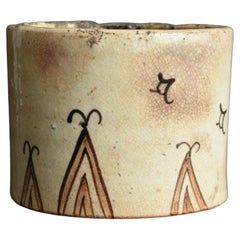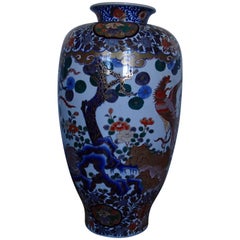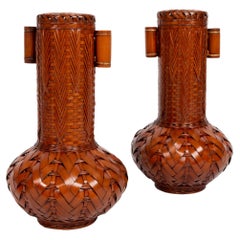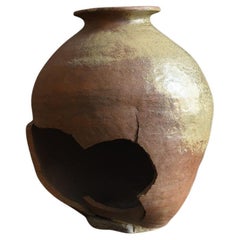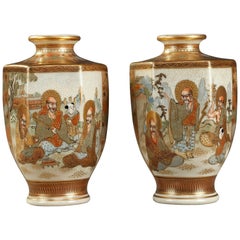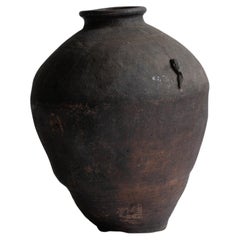Japanese Vases
to
312
1,196
317
21
38
569
589
338
236
154
70
29
20
13
27
3
16
26
15
21
6
88
32
23
18
17
4
3
1
1
1
985
697
629
282
197
712
418
14,018
30,195
9,647
5,765
5,301
Height
to
Width
to
1,534
1,517
1,522
38
19
16
15
15
Place of Origin: Japanese
Japanese antique painted pottery / "Eseto" / Edo period, 1800s / Ashtray
Located in Sammu-shi, Chiba
This is a pottery called Seto-yaki, which was fired in Seto, Aichi Prefecture, Japan.
Seto is a kiln with a long history in Aichi Prefecture, Japan.
(Seto kilns are marked with red c...
Category
19th Century Edo Antique Japanese Vases
Materials
Pottery
Huge Imari Vase with Email Painted with Birds and Kiku Flowers
By Imari Porcelain
Located in Schöfflisdorf, CH
Huge Imari vase with email painted with birds and kiku flowers.
Category
20th Century Japonisme Japanese Vases
Materials
Porcelain, Paint
Pair Japanese Lacquered Woven Bamboo Ikebana Vases, Japan, C.1950
Located in London, GB
Pair Of Showa Period Japanese Lacquered Woven Bamboo Ikebana Vases, Japan, C.1950
The word Ikebana translates as the Japanese art of flower arrang...
Category
Mid-20th Century Showa Japanese Vases
Materials
Bamboo
Japanese antique pottery "Tamba" ware/15th to 16th century/rare Jar
Located in Sammu-shi, Chiba
I would like to introduce rare and interesting Japanese antique pottery.
This is called "Tamba ware" in Japan.
Tamba is a historic kiln located in Hyogo prefecture, Japan. (The part ...
Category
15th Century and Earlier Other Antique Japanese Vases
Materials
Pottery
20th Century Pair of Small Porcelain Satsuma Vases
By Satsuma
Located in Paris, FR
Two porcelain hexagonal Satsuma vases painted in polychrome enamels and gold. The paunch is decorated with intricate Japanese characters in a landscape, the neck and the shoulder wit...
Category
Early 19th Century Japonisme Antique Japanese Vases
Materials
Porcelain
Japanese Antique Wabi-Sabi Edo Pottery Vase 18th Century / Tsubo
Located in Sammu-shi, Chiba
This is a very old ceramic vase made in Japan.
It was made in the Edo period (1860s-1860s).
It is called Shigaraki ware in Japan.
This large vase was used to hold and carry tea leav...
Category
Late 17th Century Edo Antique Japanese Vases
Materials
Pottery
Satsuma Vase with Figures
Located in New Orleans, LA
This Japanese Satsuma vase is intricately decorated with geometric patterns and lively scenes of leisure activities including calligraphy and a friendly game of Go. The vase presents...
Category
19th Century Meiji Antique Japanese Vases
Materials
Earthenware
Rare Signed Ando Jubei Ginbari Red Japanese Cloisonne Vase Roses 9"
By Ando Jubei
Located in Somis, CA
A rare Ando Jubei ginbari cloisonne vase. On the body two branches of white roses in full bloom and bud form with verdant foliage, worked in meticulous detail, set against stunning m...
Category
20th Century Showa Japanese Vases
Materials
Metal, Enamel
$792 Sale Price
39% Off
Pair of 19th Century Japanese Porcelain Kutani Vases
Located in Los Angeles, CA
Pair of late 19th century Japanese hand-painted and gilded porcelain kutani vases. These vases are signed.
Category
19th Century Antique Japanese Vases
Materials
Porcelain
Toyo Modernist Ikebana Two Tiered Ceramic Planter / Vase, Japan c.1965
By Toyo
Located in San Juan Capistrano, CA
Toyo Modernist Two Tiered Ceramic Planter / Vase, Japan c.1965.
Category
20th Century Mid-Century Modern Japanese Vases
Materials
Ceramic
$260 Sale Price
20% Off
Japanese Contemporary Imari Blue Porcelain Vase by Master Artist
Located in Takarazuka, JP
Exquisite Japanese contemporary decorative porcelain vase, hand painted in blue on a beautifully shaped body in pure white, a signed piece by widely acclaimed master porcelain artist...
Category
21st Century and Contemporary Japanese Vases
Materials
Porcelain
1960s Japanese Bud Vase Dark Brown Glaze
Located in Chula Vista, CA
1960s Japanese Weed Pot Vase Dark Brown Glaze
3.75 diameter x 4.5 h
Signed but unable to read.
Original vintage condition
Refer to images.
Category
1960s Mid-Century Modern Vintage Japanese Vases
Materials
Pottery
Unusual pair of antique 19th century quality Japanese satsuma vases
Located in Ipswich, GB
Unusual pair of antique 19th century quality Japanese satsuma vases, having unusual hand painted panels in wonderful blue, red, brown and gold colours, with dog of fo handles to the ...
Category
Early 19th Century Early Victorian Antique Japanese Vases
Materials
Ceramic
Rare and Large Japanese Porcelain Vase Makuzu Kozan
By Makuzu Kozan
Located in Atlanta, GA
A striking blue and white vase from the studio of Japanese Potter Makuzu Kozan, also known as Miyagawa Kozan (1842–1916), one of the most established and collected ceramist from Meiji Period. Born as Miyagawa Toranosuke, Kozan established his pottery studio in Yokohama around 1870s and later became one of the appointed artist to the Japanese Imperial household. His work was exhibited in many international fairs that the Meiji government participated at the turn of the century and won many grand prizes.
With an impressively large size, this vase was likely made and reserved as a presentation piece for one of the many expositions the studio participated in the early 20th century. It was decorated with underglaze cobalt blue using the novel technique developed by Kozan called Fuki-e (the blow painting), in order to achieve the striking dimensional literary landscape known as "Mountain and Water". Being one of the most creative ceramists, Kozan started experimenting with new chemical colors from the West in the format of his porcelain glaze around 1880s. New colors allowed him to create underglaze designs that appeared bright, smooth and glossy. He even invented his own receipt of cobalt blue to achieve a much brighter yet softer shade, as evident on this vase. To create landscape that is realistic and dimensional, more common in the western paintings, he was inspired by the native Japanese ink painting technique developed around 1900 by Yokoyama Taikan...
Category
Early 20th Century Japonisme Japanese Vases
Materials
Porcelain
Lovely Meiji Japanese Scroll Paintings Japan Tomobako Tamazusa Kawabata 1
Located in Amsterdam, Noord Holland
Great decorated pieces
Tamazusa Kawabata 1842 to 1913 Japan painter. Kyoto student. His name is Takinosuke, Keitei in another issue, and Kei in his later years. At the age of eleven...
Category
19th Century Antique Japanese Vases
Materials
Paper
Japanese Satsuma Vase Landscape Figural Decoration Marked, 19th Century
Located in Amsterdam, Noord Holland
Fabulous Japanese earthenware Satsuma bowl with nice decoration of a landscape with figures. Meiji period, 19th c.
Lovely piece.
Additional information:
Material: Porcelain & Pott...
Category
19th Century Meiji Antique Japanese Vases
Materials
Porcelain
Chinese Peking Cut Blue & White Cameo Glass Vase, Ca. ca. 1900-1920
Located in New York, NY
Chinese Peking Cut Blue & White Cameo Glass Vase, Ca. ca.1900-1920
DIMENSIONS:
Height: 12.5 inches
Diameter: 5.5 inches
ABOUT CHINESE PEKING GLASS
Peking cut blue ...
Category
1910s Japonisme Vintage Japanese Vases
Materials
Glass
Large Pair 19th Century Japanese Imari Vases
Located in Brighton, Sussex
A very good quality pair of large late 19th Century Japanese Imari vases, each with rippled flared necks, classical hand painted motif decoration to the boarders, and inset panels de...
Category
Late 19th Century Antique Japanese Vases
Materials
Porcelain
$20,200 / set
Antique Mixed Metal Japanese Vase Bronze, Japan, 19th/20th Century
Located in Amsterdam, Noord Holland
Interesting and finely made mixed metal shibuichi vase. Very cool.
Additional information:
Material: Bronze & Cloisonne
Region of Origin: Japan
Period: 19th century
Japan Dynasty Pe...
Category
19th Century Meiji Antique Japanese Vases
Materials
Bronze
$545 Sale Price
20% Off
Japanese Contemporary Blue White Porcelain Vase by Master Artist, 4
Located in Takarazuka, JP
Exquisite contemporary Japanese decorative porcelain vase, intricately hand painted in various shades of blue on a stunning bottle shape body, a signed work by highly acclaimed award...
Category
21st Century and Contemporary Meiji Japanese Vases
Materials
Porcelain
Fine Japanese Satsuma Vase with Superb Decoration by Seikozan
Located in Atlanta, GA
A ceramic vase in tapered square form made by Japanese studio Seikozan circa 1890-1910s (late Meiji Period). One of the many artist studios that specialized in satsuma ware, Seikozan...
Category
1880s Meiji Antique Japanese Vases
Materials
Ceramic
Japanese Contemporary Blue Gold Red Pink Porcelain Vase by Master Artist
Located in Takarazuka, JP
Exquisite contemporary Japanese decorative Porcelain vase, intricately gilded and hand painted in hues of red, blue and gold on a striking globular body, a signed work by highly accl...
Category
21st Century and Contemporary Japanese Vases
Materials
Gold
Contemporary Japanese Blue Black Green Porcelain Vase by Master Artist
Located in Takarazuka, JP
Exquisite Japanese Contemporary decorative porcelain vase, extremely intricately hand painted In vivid green and blue on a stunningly shaped body, featuring a “flowers-in-the-wind” m...
Category
21st Century and Contemporary Japanese Vases
Materials
Porcelain
Japanese Ceramic Vase
Located in Palm Desert, CA
Very unique Japanese vase with abstract pattern in a variety of brown tones. The deepest brown glaze is raised, giving the vase a wonderful tactile texture.
Category
Late 20th Century Organic Modern Japanese Vases
Materials
Ceramic
Large Japanese Blue Green Red Porcelain Vase by Contemporary Master Artist
Located in Takarazuka, JP
Exquisite Japanese contemporary ko-Imari (old Imari) style hand-painted decorative porcelain vase in green, red and blue , a signed masterpiece by widely acclaimed master porcelain a...
Category
21st Century and Contemporary Japanese Vases
Materials
Gold
Large Sculptural Ceramic Vessel by Mihara Ken
Located in Atlanta, GA
A large ceramic vessel in an impressive geometrical form by Japanese potter Mihara Ken (1958-) made in 2007. This multi-fired stoneware in shape of a mounta...
Category
Early 2000s Modern Japanese Vases
Materials
Ceramic
Large Meiji Period Cloisonne Enamel Vase
Located in London, GB
Of ovoid form, with a narrow neck and outward flaring rim, on dark blue ground depicting wisteria blossoms in white and purple cascading from the shoulder with birds throughout and w...
Category
Late 19th Century Meiji Antique Japanese Vases
Materials
Enamel
Japanese Red Black Hand-Glazed Porcelain Vase by Master Artist, 2
Located in Takarazuka, JP
Mesmerizing highly collectible Japanese decorative porcelain vase of exceptional charm, an exhibition piece, stunningly hand-glazed in vivid blue, red and black on a beautifully shap...
Category
21st Century and Contemporary Meiji Japanese Vases
Materials
Porcelain
Painted Franklin Porcelain by John Wilkinson Vase, 1980s
Located in LEGNY, FR
"The Meadowland butterfly land", beautiful Franklin porcelain vase by John Wilkinson, made in the 1980s, depicting five species of American but...
Category
1980s Vintage Japanese Vases
Materials
Porcelain
Fine Japanese Enameled Satsuma Vase by Kinkozan Meiji Period
By Kinkozan
Located in Atlanta, GA
A ceramic satsuma ware vase with very fine surface decoration made by Kinkozan circa 1880-1900s of late Meiji Period. The vase is of an elegant and relatively rare form with a trumpet shape body and the so-called garlic neck and opening. The surface is exquisitely decorated in a floral scheme with gilt and a light jewel-tone enamel. The top part showcases large bundles of wisteria blossom in white and purple, cascading down from a gilt wood trellis...
Category
1880s Meiji Antique Japanese Vases
Materials
Ceramic
Pair of Japanese Edo Period Parcel-Gilt Bronze Dragon Vases, Early 19th Century
Located in Austin, TX
A pair of well cast and dramatic Japanese parcel gilt bronze dragon vases, Edo period, early 19th century. The heavy bronze vases of pear shape, each with a single writhing dragon cast in high relief...
Category
Early 19th Century Edo Antique Japanese Vases
Materials
Bronze
Japanese Contemporary Red Green Gold Porcelain Vase by Master Artist, 3
Located in Takarazuka, JP
Contemporary Japanese decorative porcelain vase, hand painted on a stunningly shaped porcelain body in green with mesmerizing grape and vine motif in vibrant red, blue and green, asi...
Category
21st Century and Contemporary Meiji Japanese Vases
Materials
Gold
$2,310 Sale Price
30% Off
Antique Satsuma Vase with Geishas/Elegant Ladies in Landscape/Pagode Scene
Located in Amsterdam, Noord Holland
A lovely Satsuma vase with Geishas/Elegant ladies in a landscape/pagode scene. Marked base.
Additional information:
Material: Porcelain & Pottery
Japanese Style: Satsuma
Region of O...
Category
19th Century Antique Japanese Vases
Materials
Porcelain
Foo Dog Carrying Decorative Vessel
Located in New Orleans, LA
This remarkable foo dog carrying a decorative vessel embodies both artistry and symbolism, featuring a vase adorned with images of Buddhist monks adorned with gilded halos. The foo d...
Category
19th Century Meiji Antique Japanese Vases
Materials
Earthenware
Striking Cloisonné Enamel Vase by Ota Hiroaki
By Ota Hiroaki
Located in Lymington, Hampshire
A striking cloisonné enamel vase with gold and green gin-bari decoration by Ota Hiroaki, the body with a continuous frieze of scrolling green leaves and flowerheads on a white ground...
Category
Mid-20th Century Showa Japanese Vases
Materials
Ceramic
Mid Century Ceramic Weed Pot, Japan, 20th Century
Located in San Juan Capistrano, CA
Mid Century Ceramic Weed Pot, Japan, 20th Century.
Category
20th Century Mid-Century Modern Japanese Vases
Materials
Ceramic
Antique Bronze Meiji Vase with Fishes and Mark Shobun Jyuhachi, 19th Century
Located in Amsterdam, Noord Holland
Nicely made vase with a great color shading. Marked on the side: Shobun jyuhachi
Additional information:
Material: Porcelain & Pottery
Region of Origin: Japan
Period: 19th century E...
Category
19th Century Meiji Antique Japanese Vases
Materials
Pottery
$1,618 Sale Price
20% Off
Antique Japanese Meiji Ginbari Cloisonne Enamel Vase
Located in Long Island City, NY
An antique Japanese, late Meiji era, Ginbari enamel over copper vase. The urn shaped vase is enameled with a polychrome image of blossoming flowers on the light blue ground made in t...
Category
Late 19th Century Meiji Antique Japanese Vases
Materials
Copper, Enamel
Large Satsuma lidded vase, late 19th Century
By Satsuma
Located in Brighton, Sussex
A very impressive, fine quality Japanese Satsuma lidded vase. Having inset hand painted fan shaped panels depicting Warriors, ships, mountainous scenes, set between classical hand pa...
Category
Late 19th Century Antique Japanese Vases
Materials
Porcelain
Antique Cloisonne Bronze Vase, Japan, 19th Century, Rare Antique Vase
Located in Bastogne, BE
A bronze and cloisonne enamel square vase.
Cloisonne bronze vase, Japan XIX, signature cartridge.
Large quadrangular bronze vase, Japanese work from the 19th century, signed b...
Category
19th Century Antique Japanese Vases
Materials
Bronze
Antique Decorative Posy Vase, Japanese, Bronze, Meiji Period, Urn, Victorian
Located in Hele, Devon, GB
This is an antique decorative posy vase. A Japanese, bronze Meiji period urn, dating to the late 19th century, circa 1900.
Adorned with superb relief bird figures over a wonderful bulb form
Displaying a desirable aged patina with minimal weathering
Bronze shows appealing tonality with a warm chestnut colouration
Decorated with the hallmarks of the Meiji period of Japanese history (1868-1912)
Wide flared rim with a flat top edge, with an opening diameter of 10cm (4'')
Decorative relief birds sit prominently around the body
Large phoenix type bird to the front fascia, the ground accentuated with engraved foliate patterns
Traditional character mark can be found upon the base
This is a fascinating antique decorative posy vase, with classical Japanese...
Category
Late 19th Century Antique Japanese Vases
Materials
Bronze
Mid-Century / Postmodern Ikebana Style Ceramic Vase
By Toyo
Located in San Diego, CA
Beautiful ceramic vase with a blue glossy glaze, circa 1970s retains label Made in Japan by Toyo no chips or cracks. also has a secondary label on the...
Category
Late 20th Century Mid-Century Modern Japanese Vases
Materials
Ceramic
$220 Sale Price
20% Off
Fine Art Japanese Winter Bamboo Vases Arita Hat stand shap
By Fujii Shumei
Located in Amsterdam, Noord Holland
Super pair of bamboo vases. Meiji period ca 1890
Category
19th Century Antique Japanese Vases
Materials
Bronze
$2,160 Sale Price
20% Off
Japanese Decorative Vessel, Japan, Wabi Sabi, Early 20th Century
Located in Edogawa-ku Tokyo, JP
Japanese vessel with rounded body and slender neck, the form recalls both sake bottles and flower vases, embodying the versatile aesthetics of Japanese decorative arts. The surface i...
Category
Early 20th Century Japanese Vases
Materials
Metal
Vintage Awaji Pottery Manipulated Drip Vase
By Awaji Pottery
Located in Wilton, CT
Large Awaji pottery drip vase with thick, multicolored lava glaze suspended above the unglazed lower portion of the vase. Impressed four character mark on side of base. Drill hole pr...
Category
1930s Modern Vintage Japanese Vases
Materials
Pottery
Japanese Contemporary Blue Red Purple Gold Porcelain Vase by Master Artist, 2
Located in Takarazuka, JP
Mesmerizing Japanese contemporary dimpled gilded signed decorative porcelain vase, an exquisite masterpiece hand painted by widely acclaimed master porcelain artist of Japan’s Imari-...
Category
21st Century and Contemporary Meiji Japanese Vases
Materials
Gold
Japanese Contemporary Green Red Blue Gold Porcelain Vase by Master Artist, 2
Located in Takarazuka, JP
Exceptional Japanese contemporary highly collectible decorative porcelain vase, hand painted in extremely intricate patterns and extensive gold details on vibrant red, yellow, blue/g...
Category
21st Century and Contemporary Meiji Japanese Vases
Materials
Gold
$6,850 Sale Price
45% Off
Ando Company, Fine Cloisonne Vase with Roses, Signed, Japan, 20th Century
By Ando Jubei
Located in Chatham, ON
ANDO CLOISONNÉ COMPANY - Extraordinary cloisonné vase with roses and transparent green enamel over raised bamboo decoration - green enamel to the interi...
Category
20th Century Japonisme Japanese Vases
Materials
Metal
Japanese Modern Studio Ceramic Oribe Jar by Ryoji Koie
By Ryoji Koie
Located in Atlanta, GA
A glazed ceramic vessel by Japanese potter Ryoji Koie (1938-2020). Hand-built with intention to be seen as such, the tsubo has a primordial irregular form with a small opening and a swelled body resembling a beehive. The upper body was covered in a glassy green oribe glaze with fine crackles, highlighted with three incised geometrical symbols. The lower body is unglazed and exposed the white clay with marks of the hand-making pinches and kneading along the base. The base also shows highly irregular surface due to the seashell spur marks and clay pitting in the kiln during the firing process. All these occurrences honestly preserved and presented as part of the character of this wonderful modern piece. The jar comes with a plain wooden tomobako box.
"One of Japan’s most versatile and forward-thinking contemporary artists, KOIE RYOJI...
Category
21st Century and Contemporary Modern Japanese Vases
Materials
Ceramic
Japanese Ikebana Ceramic Vase
Located in San Diego, CA
Beautiful Japanese ikebana white ceramic vase, circa 1960s. The vase is in great shape with no chips or cracks and has a wonderful mid-century circular...
Category
20th Century Mid-Century Modern Japanese Vases
Materials
Ceramic
Japanese Green Blue White Porcelain Vase by Contemporary Master Artist, 2
Located in Takarazuka, JP
Exquisite hand painted Japanese contemporary porcelain vase created by acclaimed award-winning master artist from the Imari- Arita region of Japan, featuring a stunning arabesque pat...
Category
21st Century and Contemporary Meiji Japanese Vases
Materials
Porcelain
Japanese Contemporary Black Platinum Porcelain Vase by Master Artist, 5
Located in Takarazuka, JP
Exquisite Japanese contemporary decorative porcelain vase, intricately hand painted in platinum, set against a beautiful round shaped body in black, a signed piece belonging to the artist's signature fish collection by highly acclaimed master porcelain artist and recipient of numerous awards for his exceptional and extraordinary porcelain work and his unique signature gold and platinum work on porcelain. In 2016, the British Museum added a work by this award-winning artist to its collection of contemporary Japanese porcelain in the Imari-Arita polychrome enamel tradition. The artist's profile is available upon request.
Based on the Chinese legend...
Category
21st Century and Contemporary Meiji Japanese Vases
Materials
Platinum
Japanese Contemporary Platinum Black Porcelain Vase by Master Artist, 9
Located in Takarazuka, JP
Japanese contemporary decorative porcelain vase, dramatically hand painted in platinum, set against a beautifully shaped porcelain body in black, a signed piece belonging to the artist's signature fish collection by highly acclaimed master porcelain artist and recipient of numerous awards for his exceptional and extraordinary porcelain work and his unique signature gold and platinum work on porcelain. In 2016, the British Museum added a work by this award-winning artist to its collection of contemporary Japanese porcelain in the Imari-Arita polychrome enamel tradition. The artist's profile is available upon request.
According to a Chinese legend...
Category
21st Century and Contemporary Adirondack Japanese Vases
Materials
Platinum
Japanese antique pottery small vase / Karatsu ware / Edo period / Kyushu region
Located in Sammu-shi, Chiba
This is Takeo Karatsu pottery, believed to have been fired during the Edo period (circa 17th to 19th centuries).
Karatsu ware is traditional Japanese ceramics made in the Karatsu reg...
Category
19th Century Edo Antique Japanese Vases
Materials
Pottery
Japanese Contemporary Green White Blue Porcelain Vase by Master Artist Duo
Located in Takarazuka, JP
Extraordinary Japanese contemporary highly museum quality decorative porcelain vase. This masterpiece is the collaborative work of two brothers and signed by both, highly acclaimed second-generation master porcelain artists of the Imari-Arita region of Japan. The older brother excels in the depiction of breathtaking natural scenes while the younger brother specializes in creating intricate geometric patterns, which in this piece are found in the neck and base of the vase.
It depicts stunning scenes from the famous Japanese Classic literature...
Category
21st Century and Contemporary Meiji Japanese Vases
Materials
Gold
$5,250 Sale Price
44% Off
Pair 19th Century Japanese Imari Porcelain & Gilt-Bronze Torchere Candelabra
By Imari Porcelain
Located in Los Angeles, CA
A fine Pair of 19th century Japanese Imari Porcelain and French Gilt-Bronze Mounted Thirteen-Light Celadon Torchere Candelabra. The bottle-shaped Japonisme vases with a Royal red background, decorated with parcel-gilt and black soaring eagles in the hunt within a forestall scene. Each Vase fitted and surmounted with a French 19th century Louis XV Style 13-Light scrolled candelabrum and all raised on a circular pierced gilt-bronze plinth. circa: 1880.
Imari Porcelain (????) is the name for Japanese porcelain wares made in the town of Arita, in the former Hizen Province, northwestern Kyushu. They were exported to Europe extensively from the port of Imari, Saga, between the second half of the 17th century and the first half of the 18th century. The Japanese as well as Europeans called them Imari. In Japanese, these porcelains are also known as Arita-yaki (???). Imari or Arita porcelain has been continously produced up through the present day.
Characteristics
Though there are many types of Imari, Westerners' conception of Imari in the popular sense is associated only with a type of Imari produced and exported in large quantity in mid-17th century. This type is called Kinrande. Kinrande Imari is colored porcelain with cobalt blue underglaze and red and gold overglaze. The color combination was not seen in China at that time. Traditional Ming dynasty color porcelain used dominantly red and green, probably due to scarcity of gold in China, whereas gold was abundant in Japan in those days. The subject matter of Imari is diverse, ranging from foliage and flowers to people, scenery and abstractions. Some Imari design structures such as kraak style were adopted from China, but most designs were uniquely Japanese owing to the rich Japanese tradition of paintings and costume design. The porcelain has a gritty texture on the bases, where it is not covered by glaze. There is also blue and white Imari. Kakiemon style Imari is another type of Imari, but it tends to be categorized separately in Europe.
History
"Imari" was simply the trans-shipment port for Arita wares. It was the kilns at Arita which formed the heart of the Japanese porcelain industry.
Arita's kilns were set up in the 17th century, when kaolin was discovered in 1616 by the immigrant Korean potter, Yi Sam-pyeong (1579–1655). (He may also be known by the name, "Kanage Sambei".) Yi Sam-Pyeong, along with his extended family of 180 persons, left Korea on the offer of a privileged position in Japan. This decision was made after the occurrence of certain Japanese invasions of Korea. After Yi Sam-Pyeong's discovery, his kilns began to produce revised Korean-style blue and white porcelains, known as "Shoki-Imari".
In the mid-17th century there were also a lot of Chinese refugees in Northern Kyushu due to the turmoil on Chinese continent, and it is said one of them brought coloring technique to Arita. Thus Shoki-Imari developed into Ko-KutaniImari. Ko-Kutani was produced around 1650 for both export and domestic market. Blue and white porcelain continued to be produced and they are called Ai-Kutani. Ko-Kutani Imari for the export market usually adopted Chinese design structure such as kraak style, whereas Ai-Kutani for the domestic market were highly unique in design and are accordingly valued very much among collectors.
Ko-Kutani style evolved into Kakiemon style Imari, which was produced for about 50 years around 1700. Imari achieved its technical and aesthetic peak in Kakiemon style, and it dominated European market. Blue and white Kakiemon is called Ai-Kakiemon. Kakiemon style transformed into Kinrande in the 18th century. Kinrande used blue underglaze and red and gold overglaze, and later some other colors.
Imari began to be exported to Europe because the Chinese kilns at Ching-te-Chen were damaged in the political chaos and the new Qing dynasty government stopped trade in 1656–1684. Exports to Europe were made through the Dutch East India Company, but the designation "Imari Porcelain" in Europe connotes Arita wares of mostly Kinrande Imari.
Export of Imari to Europe stopped in mid-18th century when China began export to Europe again, since Imari was not able to compete against China due to high labor cost. By that time, however, both Imari and Kakiemon style were already so popular among Europeans, Chinese export porcelain copied both Imari and Kakiemon style, which is called Chinese Imari. At the same time, European kilns, such as Meisen also tried to copy Imari and Kakiemon.
Export of Imari surged again in late 19th century (Meiji era) when Japonism flourished in Europe. Thus in western world today, two kinds of Imari can...
Category
19th Century Japonisme Antique Japanese Vases
Materials
Bronze, Ormolu
$24,850 Sale Price / set
49% Off
Pair of Large Japanese Imari Pattern Covered Vases, circa 1860
Located in New York, NY
Pair of large Japanese Imari pattern covered vases, circa 1860. With over-all fluting.
Category
1860s Antique Japanese Vases
Materials
Porcelain
Mid-Century / Postmodern Ikebana Style Ceramic Vase
Located in San Diego, CA
Beautiful ceramic vase with motifs, circa 1980s signed at the bottom no chips or cracks.
Category
Late 20th Century Post-Modern Japanese Vases
Materials
Ceramic
$260 Sale Price
20% Off
Porcelain Vase Blue and Red by Japanese Contemporary Master Artist
Located in Takarazuka, JP
Japanese contemporary porcelain decorative porcelain vase, hand painted in red and blue on a beautifully shaped ovoid porcelain body, a signed piece by widely acclaimed Japanese mast...
Category
21st Century and Contemporary Meiji Japanese Vases
Materials
Porcelain
Japanese Satsuma Monkey Vase, circa 1880
Located in New York, NY
In relief monkeys in a waterfall landscape setting, eating fruit.
Category
1880s Antique Japanese Vases
Materials
Porcelain
Recently Viewed
View AllMore Ways To Browse
1920s Vogue
1940s Terracotta Vase
4 Foot High Chinese Vases
Alvar Aalto Vase 3030
Antique Chinese Oxblood Vase
Antique Early 1700s
Aorta Vase
Art Nouveau Ferns
Arthur Percy For Gullaskruf
Aureliano Toso Oriente
Barbini Scavo Vase
Basket Weave Vase
Bat Vase
Bathroom Valet
Bavaria Edelstein
Belgian Vintage Crystal
Bellini Italian Vase
Bitossi Lava
